Analysing Manchester City’s attack: structural considerations and variations
Manchester City were the most potent attacking force, in Europe’s major five leagues, during the 2019/20 season. They ranked first for expected goals (xG), shots taken and goals scored compared to the other top performing teams in Europe.
Further, despite scoring less goals (per 90 minutes) than the previous season (2018/19), they managed to outperform their previous season’s average xG per 90 minutes. Such a notable attacking output has been produced in spite of encountering a higher proportion of teams that have opted to use an overtly defensive approach. Indeed, there seemed to be an increasing trend towards the use of 5-man defensive lines versus Manchester City, significantly more so than, say, Liverpool faced. They, generally, found it more difficult to create chances versus 5-man defensive lines (as reflected in their underlying attacking parameters) which made their overall attacking output all the more remarkable. Considering the above, an obvious question emerges: how did they maintain such great attacking numbers despite encountering increasingly defensive approaches?
It is important to note that these achievements existed within the context of an ever-evolving squad dynamic. There were injuries and the physical decline of certain players to contend with, balanced by the return to fitness and increasing prominence of others. A plausible line of thought would be that such adjustments to the squad dynamic may potentially coincide with difficulty in adapting cohesively and, ultimately, a downturn in form. However, for the most part, we have seen the maintenance of consistently high outputs from the key attackers within the squad – testament to Pep Guardiola’s ingenuity with regard to adapting his team’s tactical approach to enhance the impact of the talent available. Another question, then: how did Manchester City adjust their attacking processes to squeeze the most from the individuals available? The remainder of this piece, the first of a two-part series, will firstly highlight the common positional structures that Manchester City used when attempting to create chances. In part two the most frequently used, and effective, chance creation methods will be detailed.
*Note: this analysis only includes matches prior to the enforced break in play during the 2019/20 season.*
Positional structures
The opposition are an essential contributing factor when selecting an attacking approach and, aside from the individual merits of each opposing player, there are perhaps two key components to understand about the opposition’s collective method of defending: general defensive style and defensive formation. Defensive formation will be covered in detail below but, for now, a brief comment on defensive style. All teams differ in their defensive style, mainly regarding the activeness of their pressure and the extent to which they prioritise the marking of players or space. It is not possible to categorise teams cleanly, however, instead they can be viewed along a series of continuums. Manchester City did face some very active pressing teams at points in the season and, also, teams that were more man-orientated with their marking (more on this later). Nevertheless, the prevailing pattern of a large proportion of their games saw them attempting to score against a deep, packed defence and limit the opposition to as few counter-attacks as possible. As such, the majority of examples discussed below were taken from games against opposition that: maintained clear and consistent lines of defence; and were sufficiently passive to allow time for collective positioning to be established and pre-determined attacks initiated. Examples against more active and man-oriented defences are, therefore, less prevalent in this analysis.
The defensive formation used by the opposition, and thus spaces left open to attack, appears to be a key determinant that drives Guardiola’s choice of structure used when attempting to create chances. This is due to the ‘positional’ approach that Manchester City use when attacking passive, zonal defences. Positional attacking is a general term that symbolises the notion that individual players have specific spaces or channels to attack. This idea ensures that there is optimal coverage of the pitch and that players are positioned to simultaneously exploit all the spaces that the opposition leave open across the field. Regardless of ball position, players are positioned and ready to do damage throughout the width of the field (near-side, central and far-side). It is, perhaps, important to note here that ‘positional’ does not necessarily refer to playing position in a traditional sense; it is rather more concerned with constantly threatening the spaces left open by the opposition.
At the time of writing, the six most frequently faced (as denoted by the percentages in brackets) defensive formations were as follows: 1-5-3-2 (18%), 1-4-4-1-1 (14%), 1-4-2-3-1 (13%), 1-4-3-3 (9%), 1-4-1-4-1 (8%) and 1-5-4-1 (7%). As already mentioned, this marks a significant increase in opposition use of 5-man defensive lines compared to the 2018/19 season. It is necessary to mention here that defensive formations are transient; for example, a team can be playing with a back 4 generally but become a back 5,6 or even 7 situationally. Formations, then, are an important consideration but only the foundation from which numerous compensatory adjustments are made.
There were few observable and consistent differences between the structures used versus each variation of 5-man defensive line formations – likewise for each variation of the 4-man defensive line formations. For example, Manchester City’s attacking structure remained largely consistent, regardless of whether they were playing against a 1-5-3-2 or a 1-5-4-1. There were, however, significant and consistent differences between the structure used against 5-man compared to 4-man defensive line formations. As such, the most frequently used structures versus back 5 and back 4 structures will be detailed below.
Attacking a back 5
As mentioned, Manchester City attempt to threaten all channels left free by the opposition, when attacking. It therefore follows that when teams use a back 5 there are 6 vertical channels that are free to attack, as shown in the image below.
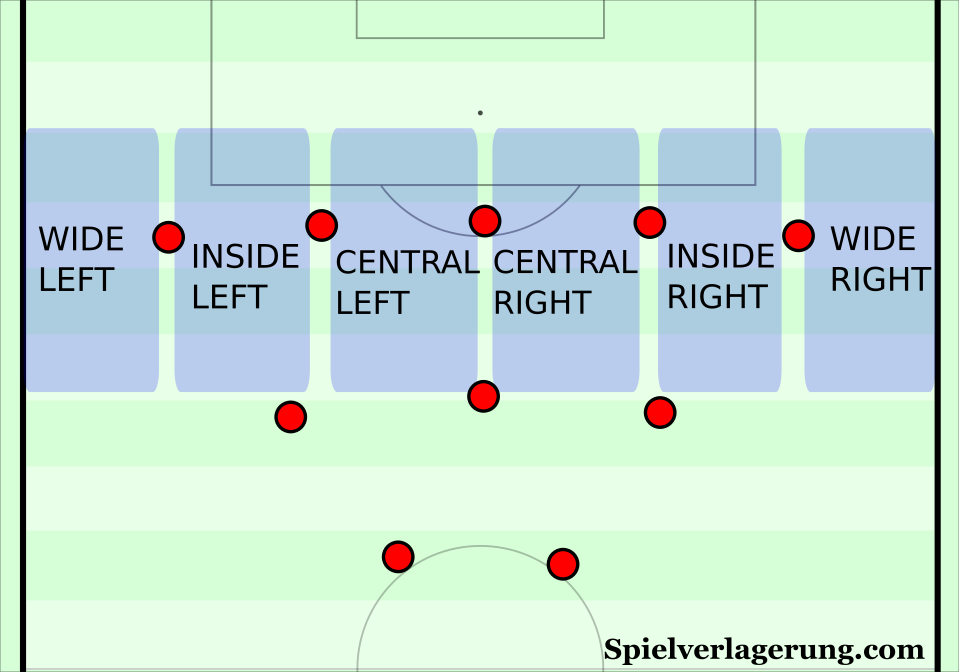
Manchester City did not always immediately fill these six channels; they sometimes chose to leave one, or even two, of the channels unattended during their deeper build-up and then dynamically filled the vacated spaces as the ball arrived in the opposition’s half. They did this from their standard 1-2-3-5 structure with a FB advancing but also from an initial 1-3-2-5 with a defensive midfielder moving up between the lines (both methods of dynamically creating the positional front 6 are shown in the diagrams below). This dynamic occupation of the remaining spaces was primarily used when playing against some of the higher placed teams in the Premier League that were generally more active with their defensive pressure such as Wolves, Sheffield United and Manchester United.
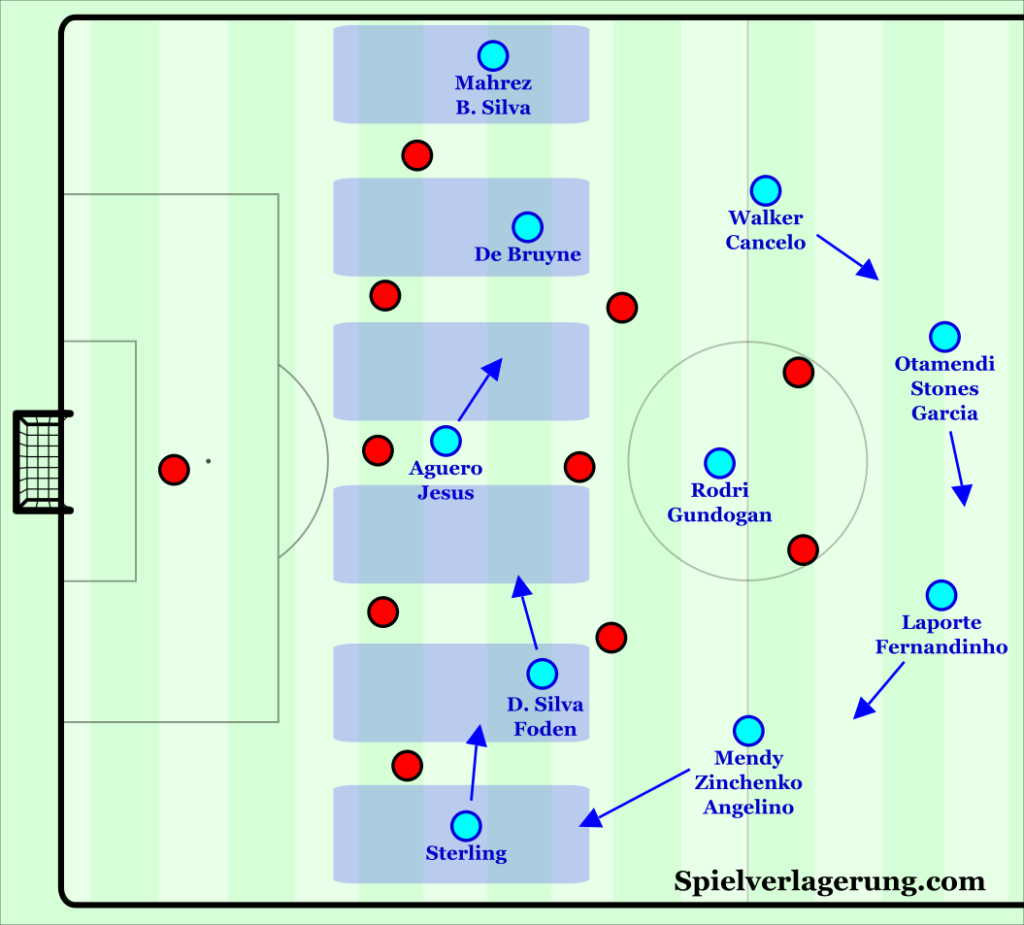
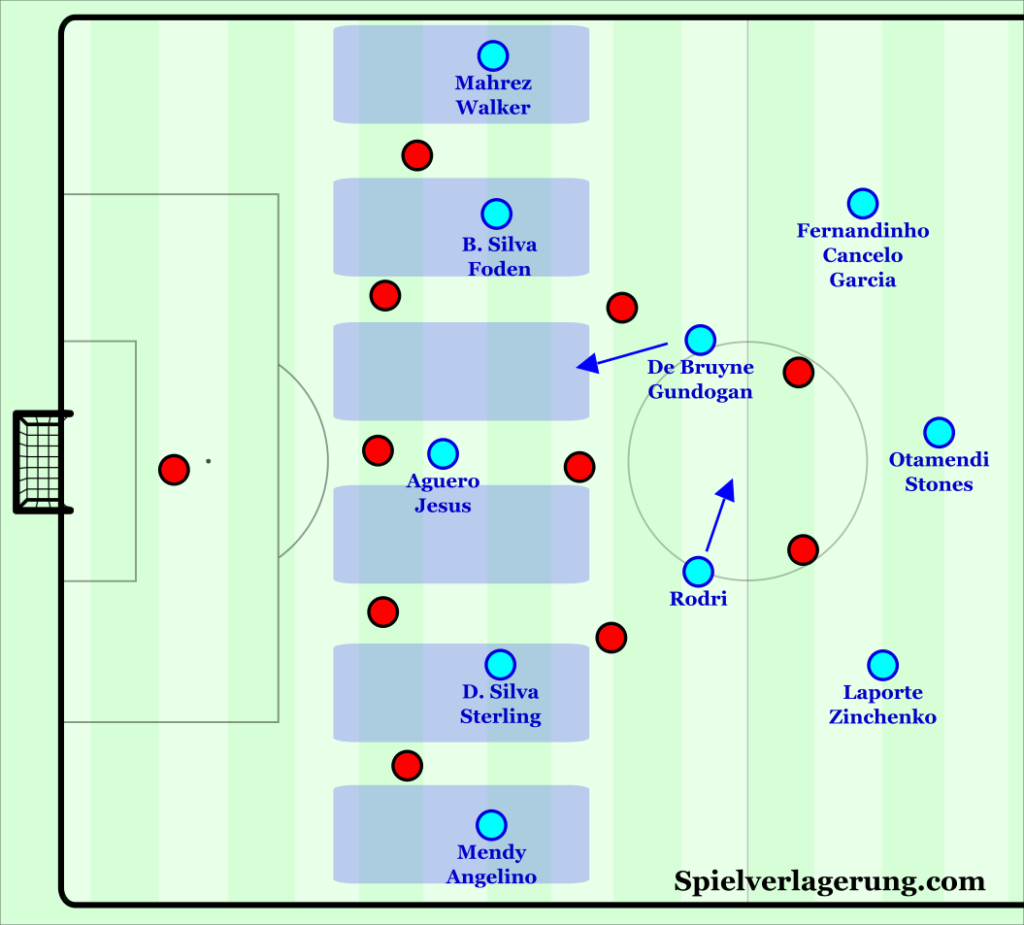
A more commonly used structure versus 5-man defences, particularly against perceived lower quality opposition, was a 1-3-1-6 or 1-1-3-6 (dependent on the position of the LCB and RCB). They mostly created this formation in two ways: from a 1-4-3-3 base shape with a FB advancing and from a 1-3-5-2 base shape with 2 central strikers, as shown below.
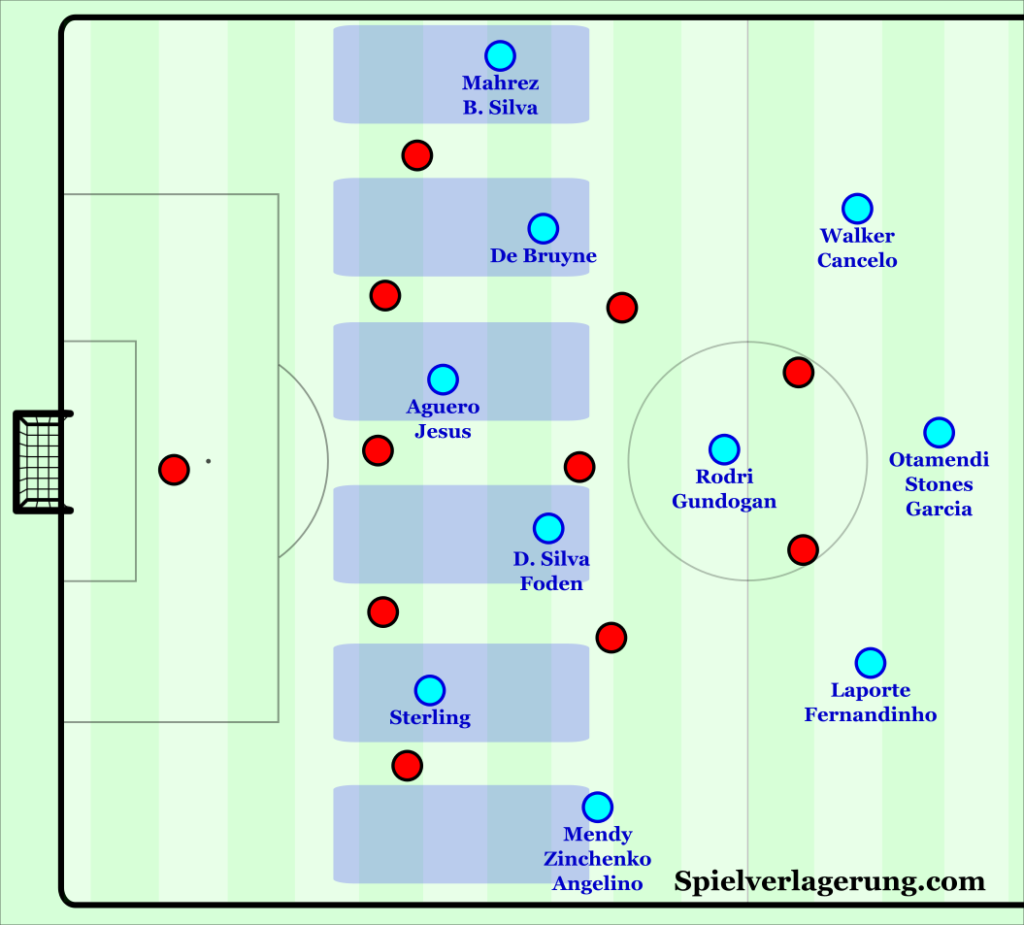
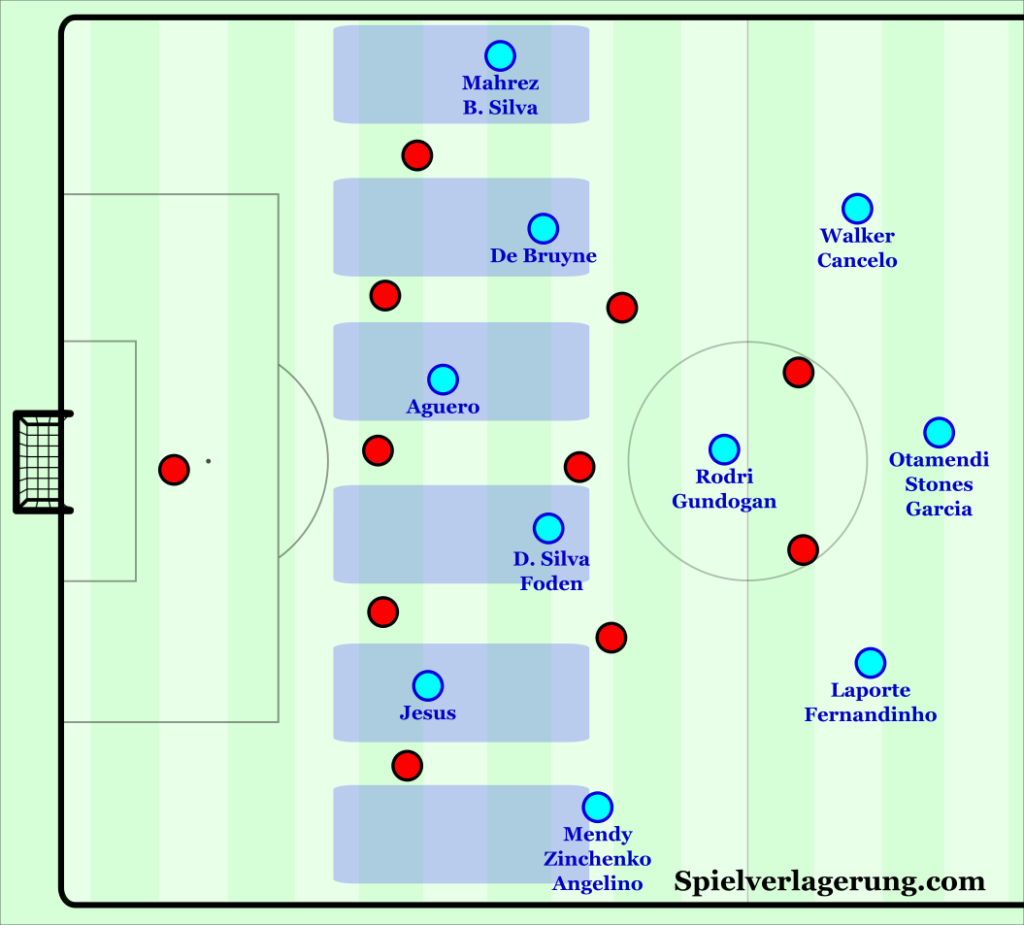
Of the front 6, the 4 central players’ movements were somewhat rotational – moving across the pitch, interchanging positions and varying the height of their positioning (two examples of this are below). Designated AMs and FBs were always ready to drop lower than the midfield line, if needed, to support the ball and help the 4 deeper players to retain possession.
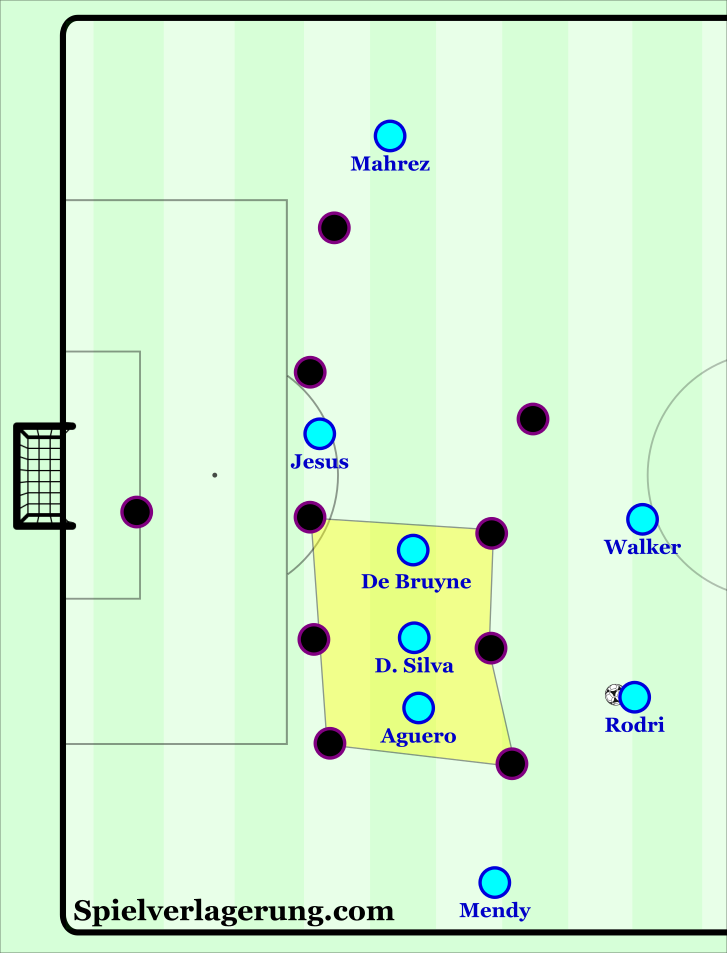
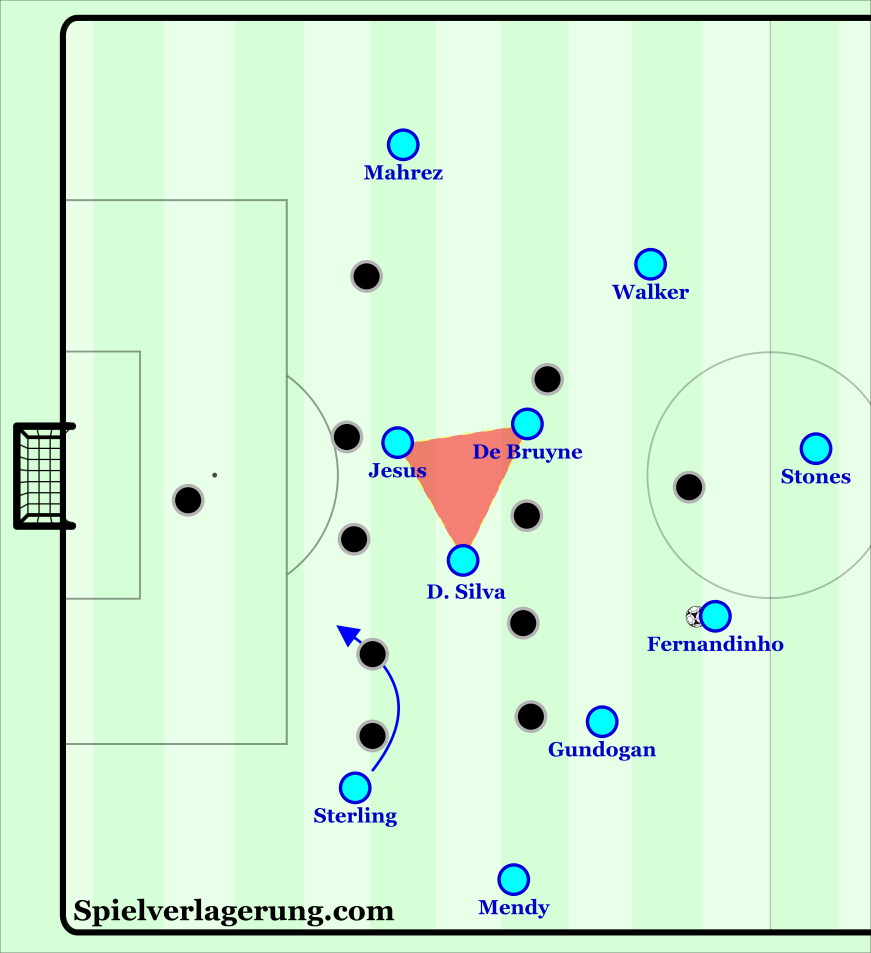
Manchester City also varied the positioning of the players behind the opposition’s midfield line. The 3-1 (or 1-3) structure has already been shown in the diagrams above but they also used a 2-2 structure versus Southampton, Dinamo Zagreb and Newcastle. It would make sense, given the well-established desire of many possession-based teams to have an extra player in their first line of build-up, for the 2-2 to be used versus teams playing 1-5-4-1 and the 3-1 to be used versus teams playing 1-5-3-2, however this did not appear to be a common theme. They created the 2-2 structure in two ways: firstly, 2 CBs in the deepest line with 2 DMs in the higher line; and secondly, 2 CBs in the deepest line with 1 DM and 1 FB in the higher line. Both are shown below.
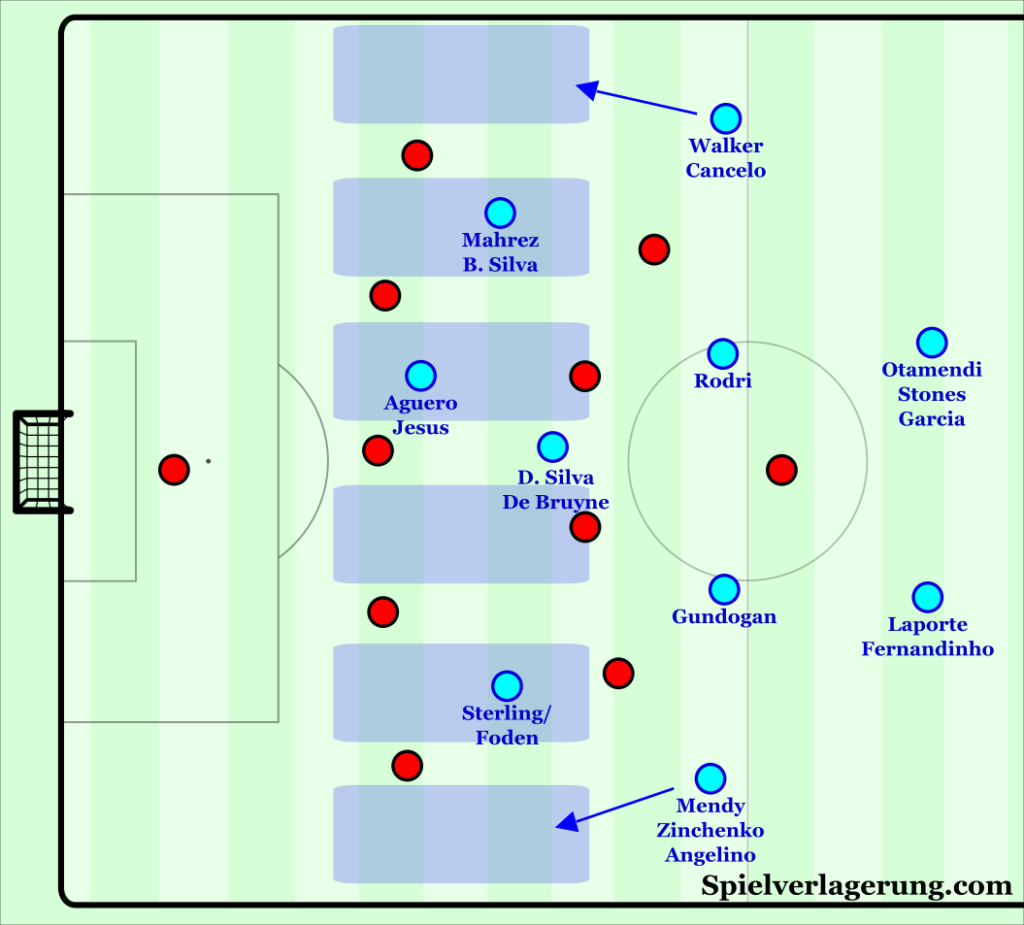
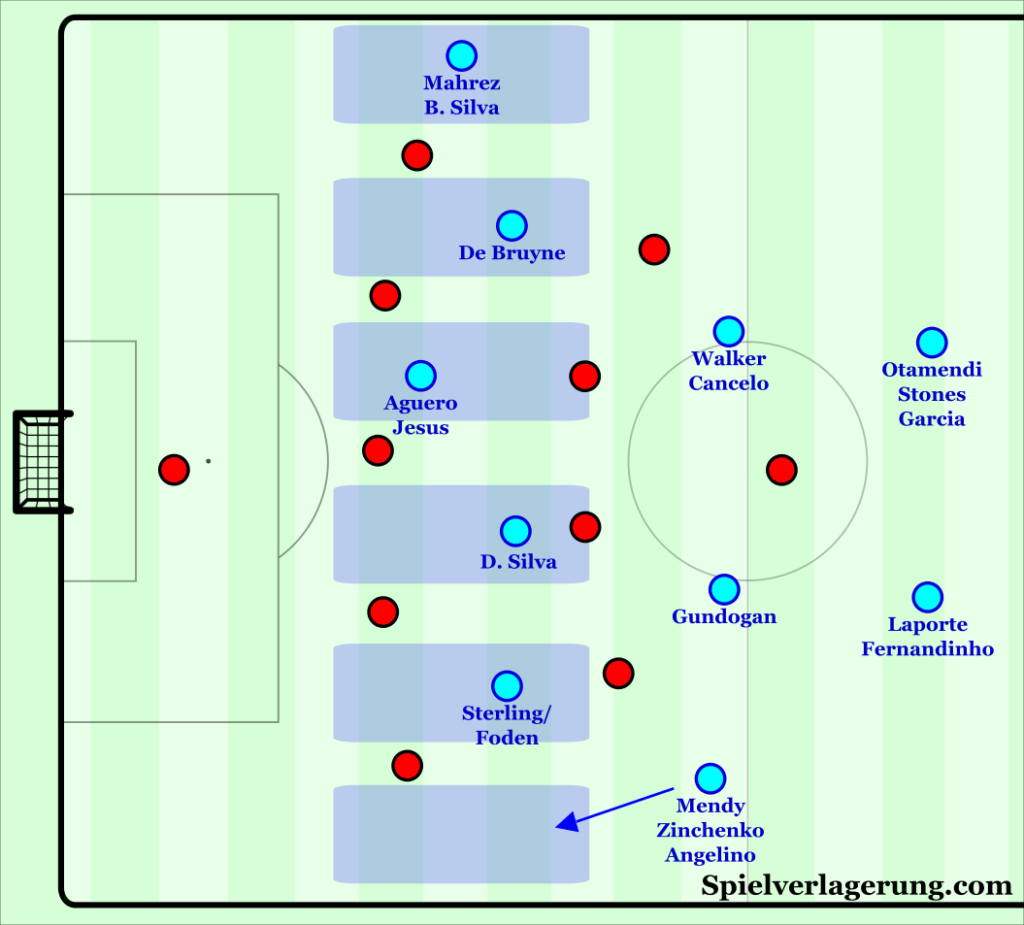
Attacking a back 4
In keeping with the positional attack concept, when attacking a back 4, there are 5 channels of space that are left free to be attacked (as shown below). As such, Manchester City predominantly used a positional front 5 versus 4-man defensive lines.
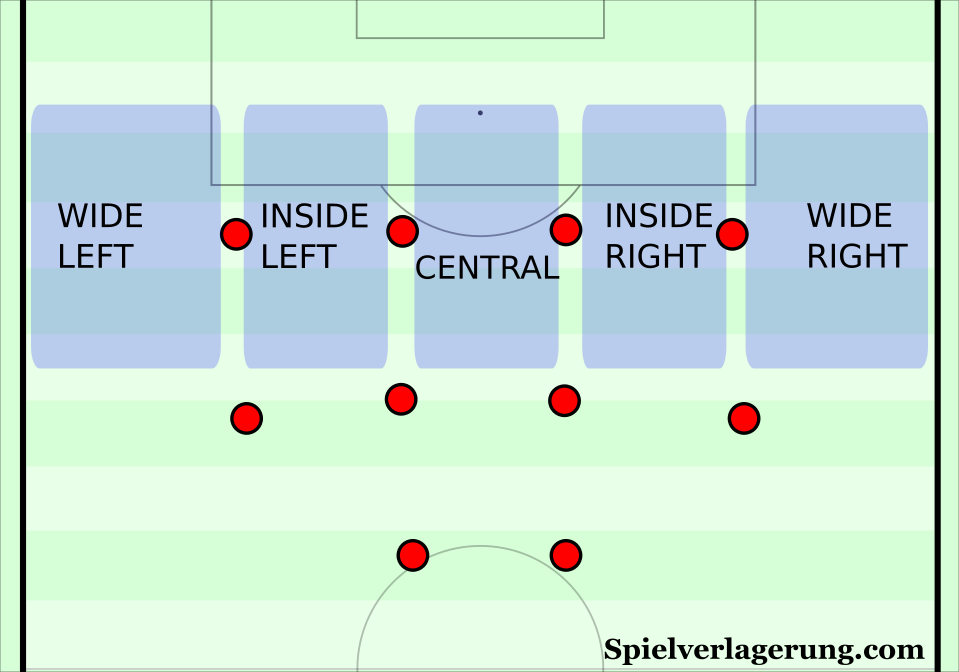
As seen in the image, 4-man defensive lines must cover the full width of the field, with one less player, creating larger channels to attack. This usually results in two responses from the opposition: either, they concede more space in the wide channels (typically giving Manchester City more time on the ball to create collective attacks or allowing them to initiate their attacks closer to goal); or their wide and central midfielders are forced to make more tracking movements to plug gaps in the defensive line.
The structure most used versus a back 4 was Manchester City’s classic 1-2-3-5, as shown below.
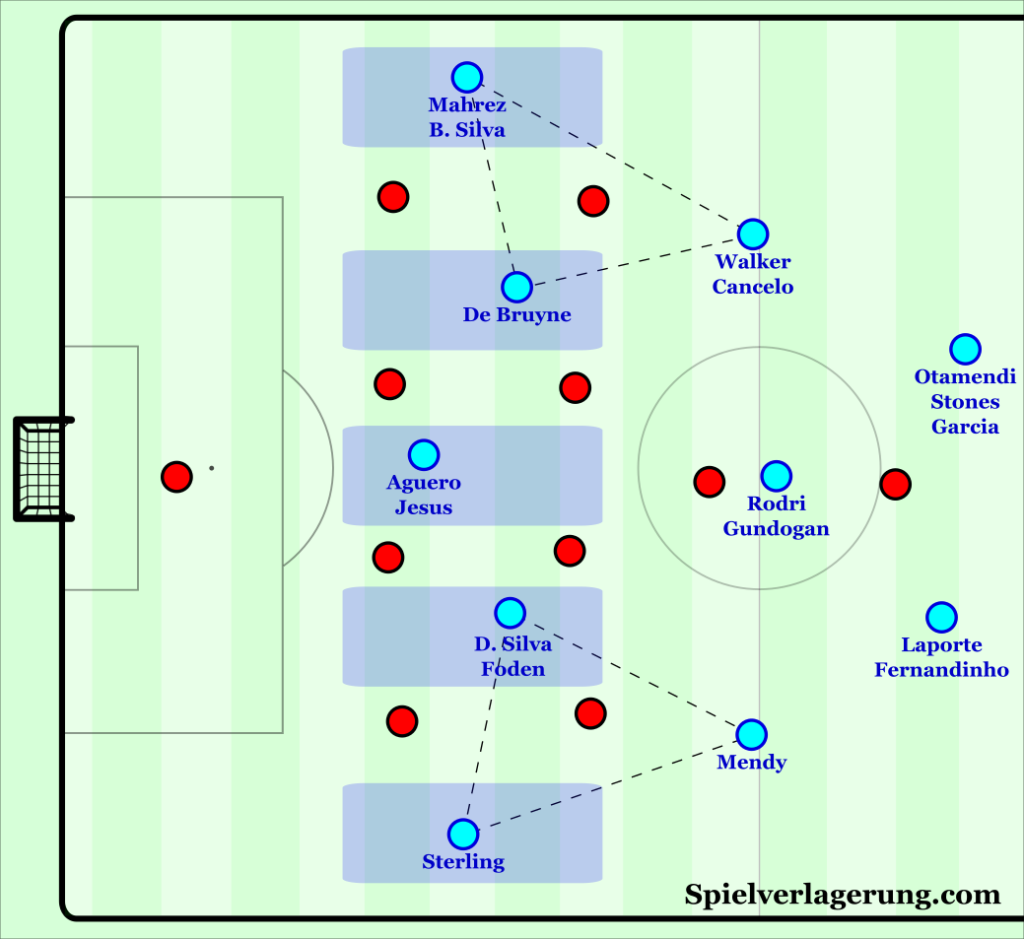
Within this structure the players were granted differing levels of freedom. The 2 CBs and DM were principally fixed in their positioning, presumably to provide a stable platform to build from. The ST was not quite as fixed as the CBs or DM (often moved to overload the inside channels) but was not quite as rotational as the triangle of players (FB, AM, W) on each side of the pitch. Those forming the wide triangle were permitted to rotate freely, provided that three key spaces were always filled. These three spaces were: ‘wide’, inside channel ‘low’ and inside channel ‘high’. The occupation of these spaces is essentially a tool for seamless progression of the ball into the final third and poor positioning can lead to difficulties in penetrating the opposition’s midfield line.
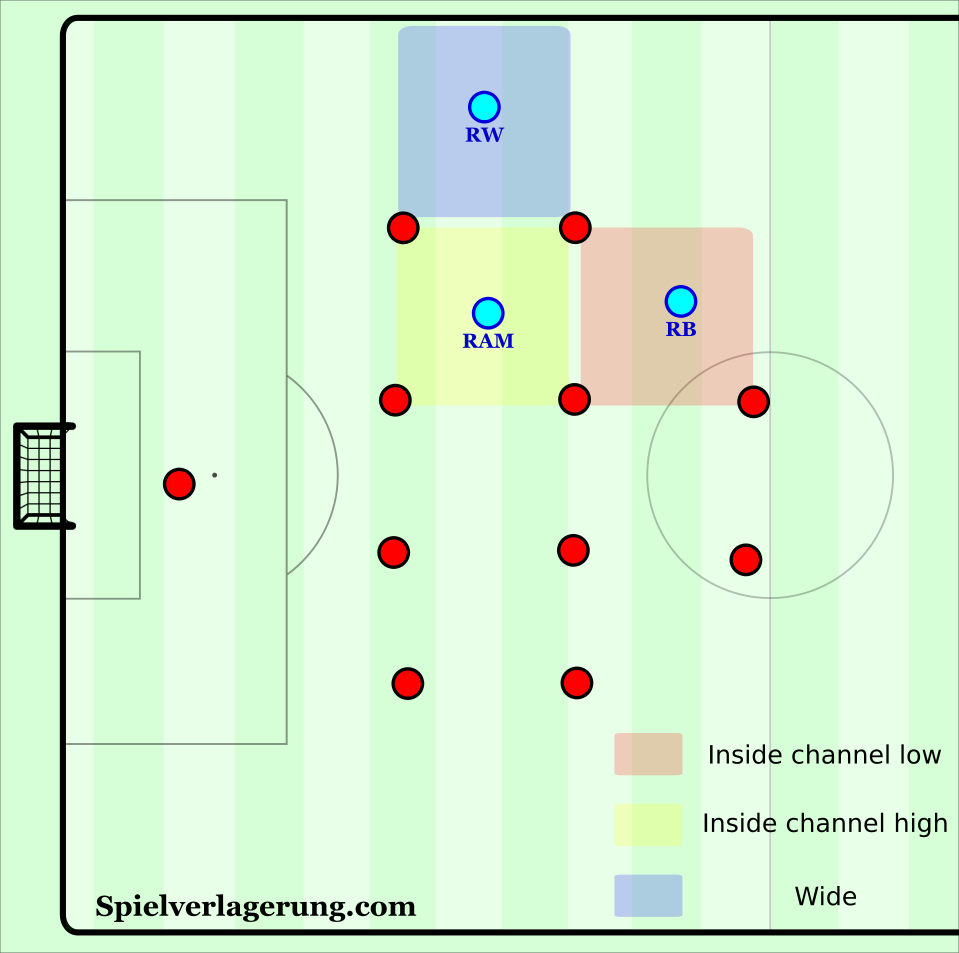
Advantages of ‘inside high’ position: fixes midfield line narrow to allow passes outside; offers a passing option if midfield line are fixed wide; occupies the attention of midfield and defensive lines; fixes opposition FB narrow (creating a favourable situation for the winger); close enough to RB and RW for well-timed rotations and combinations; can threaten last line both near and far-side; close enough to ST and opposite side for central combinations.
Advantages of ‘wide’ position: fixes midfield line wide to allow passes inside, offers a passing option if midfield line are narrow; close enough to RB and RAM for well-timed rotations and combinations; can threaten last line both near and far-side.
Whilst all players within the triangle were free to rotate, each had a space that they occupied most regularly – almost always based on the skill set of the player. For example, Kyle Walker occupied the ‘inside low’ point most frequently because he is a world class defender of counter-attacks and he often had Mahrez ‘wide’ and De Bruyne ‘inside high’ – who are both elite in their primary spaces. Each player also had a space that they rotated into most regularly. In Walker’s case, he rotated into the ‘wide’ position most regularly because he has the athleticism to be very dangerous in this space. He only occasionally moved into the ‘inside high’ position, to balance off the movements of his teammates, because he perhaps lacks the level of awareness and dexterity to operate well in small spaces.
The two most common ways that Manchester City adjusted their structure against a back 4 seemed to be, primarily, rooted in game management considerations. Firstly, when in a losing position or playing against a perceived lower quality team, they opted to use the fewest players possible in their build-up to overload the last line further – shifting to their 1-3-1-6 structure (as shown previously). They made this change when they went two goals down versus Norwich and used a front 6, from the beginning, against the 4-man defensive line of Preston North End. Secondly, when playing against the toughest opponents that press actively, Guardiola often opted to use the fewest players needed to pin the opposition’s defensive line and therefore overload the build-up moment. This approach was used against Liverpool and Real Madrid this season (as shown below) to establish early control and limit the opposition to as few attacks as possible.
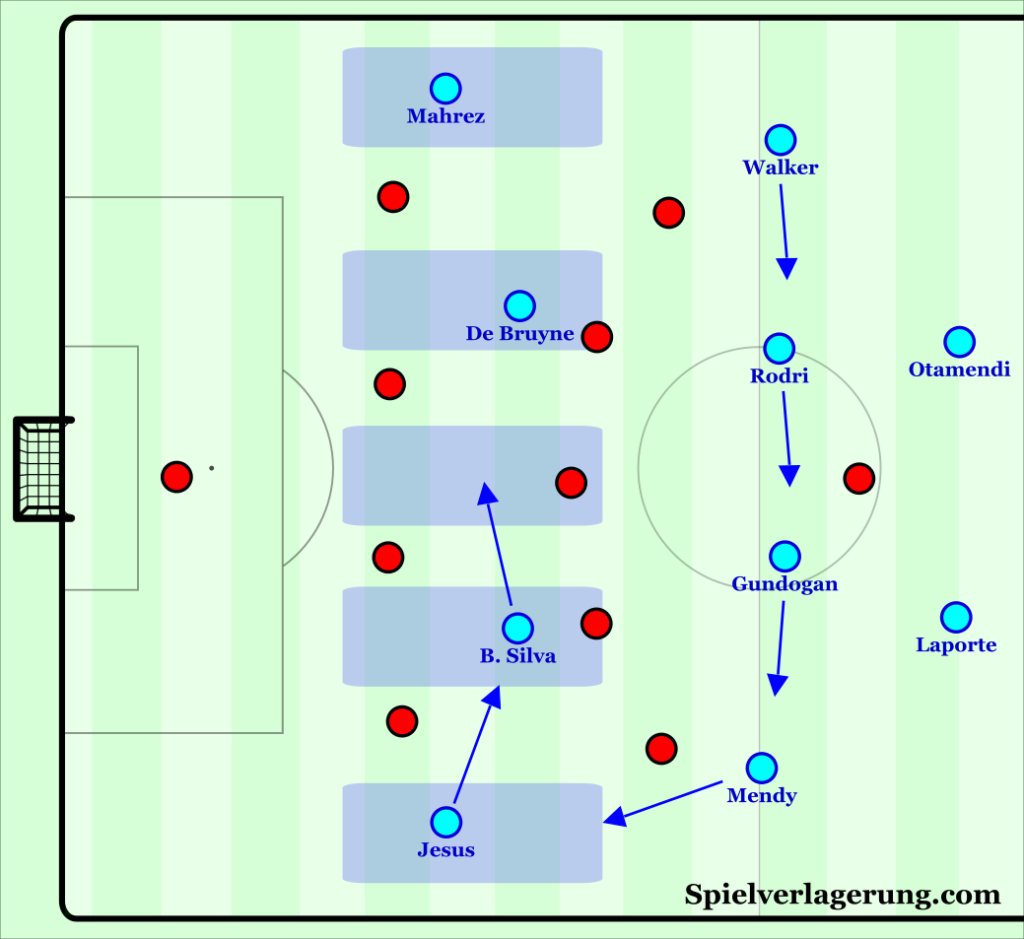
To summarise, there appeared to be some variation in structure used by Manchester City, but to a lesser extent than perhaps expected. Keeping their structure somewhat consistent potentially freed the players to focus more attention towards anticipating and responding to the movements of those around them. The players’ self-organisational qualities came to the fore in their ability to change positions in response to one another, whilst maintaining the consistent occupation of key spaces. The Manchester City players are so far into Guardiola’s process, now, that they know exactly the spaces that need to be filled dependent on the opposition, and can react to the movement of their teammates to retain structure and constant threat across the entire field. This is where we see a large degree of positional interchange, creating the illusion of players moving of their own volition but, in most cases, they are moving between spaces within a clearly defined framework.
As seen above in the graphics, there are some players that are freer to change position than others and Guardiola is fortunate to have numerous very talented players who can play in multiple spaces across the field. This allows him to considerably alter the dynamic of their attack without needing to make wholesale changes to the structure. It, thus, becomes more difficult for opposition coaches to plan a defensive strategy in advance of seeing their starting line-up. Finally, it is important to note that Guardiola clearly selects a game strategy based on multiple factors, meaning that the formation used in the opposition’s half is not always optimal on a purely systems level. Indeed, the team’s collective structure in the opposition’s half is not always the priority when selecting the strategy to win a game of football. This points to the context of the game as a critical factor contributing to the strategy used and it is necessary to be mindful that Manchester City are likely prone to the same pre-game anxieties as other teams, albeit to a lesser extent.
Whilst this part focused on Guardiola’s structural choices and variations, part 2 will examine the methods used to create chances within these structures.
Written by Charlie Turnbull
2 Kommentare Alle anzeigen
David Gregson September 23, 2020 um 6:03 pm
Absolutely love this! Any chance of doing one about the structure in the initial build up phase against differing formations also? How do they differ playing out against a team playing 433, 442, 4231 etc… Great stuff
Manu September 20, 2020 um 8:31 pm
Very nice classification of the spaces occupied by City.